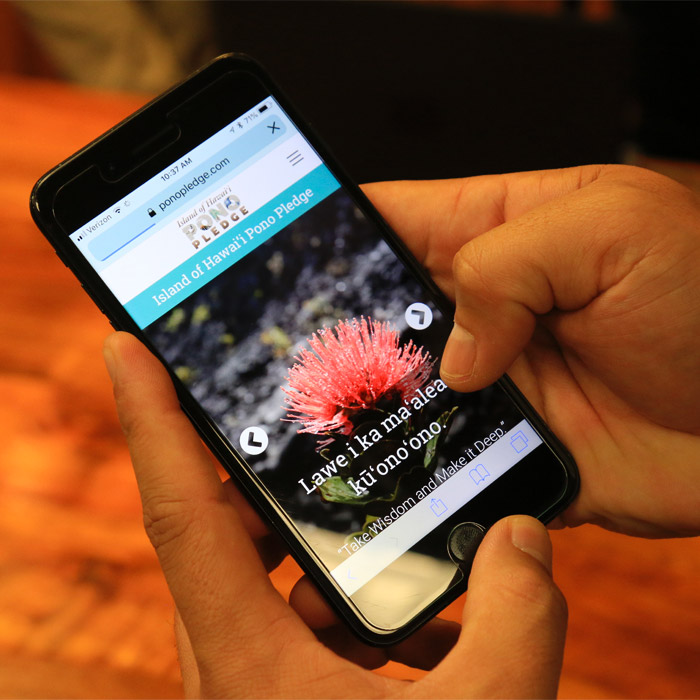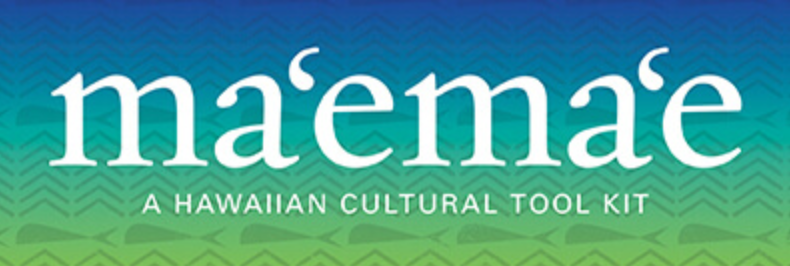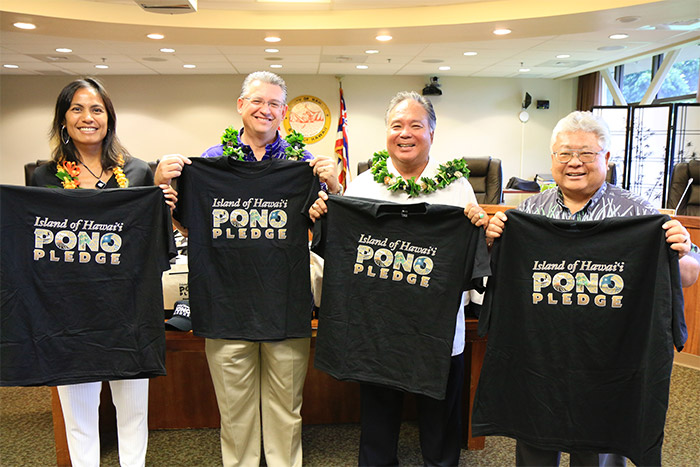I pledge to be pono (righteous) on the island of Hawaii.
THE PONO PLEDGE

Lawe i ka maalea i kuonoono.
"Take wisdom and make it deep."
1. nvs. Goodness, uprightness, morality, moral qualities, correct or proper procedure, excellence, well-being, prosperity, welfare, benefit, behalf, equity, sake, true condition or nature, duty; moral, fitting, proper, righteous, right, upright, just, virtuous, fair, beneficial, successful, in perfect order, accurate, correct, eased, relieved; should, ought, must, necessary.

Pono is a beautiful Hawaiian word, one with multi-level meaning and a lot of importance for people lucky enough to visit Hawaii. When something—a place, an event, a person’s attitude or a way of doing things—is "pono," it is in a state of correctness. It is respectful, safe, accurate and responsible.
The Pono Pledge (www.ponopledge.com), a creative new initiative by the Island of Hawaii Visitors Bureau (IHVB) and Hawaii County, encourages safe, responsible and respectful tourism. Its eight principles are simply stated, but cover a wide range of situations, experiences and thought-provoking possibilities for visitors on vacation, and for Hawaii residents as well.
Pono Timing
The basic concept of the Pono Pledge was conceived after last year’s Global Tourism Summit in Honolulu, where industry professionals shared ideas and concerns. With climate change, increase in tourist numbers and other factors for many destinations, there was a strong need to balance hospitality with protection, to preserve natural wonders and resources for future visitors, and to allow those visitors to experience these unique places, while keeping them out of harm’s way. Similar sustainable tourism pledges have been created for Iceland and Palau.
The Pono Pledge had been written and was ready to roll out earlier this year, however everything took a back seat, once Kilauea’s Lower East Rift Zone started to erupt in May. In the months since, the need for the Pono Pledge came more sharply into focus, especially while Hawaii Volcanoes National Park was temporarily closed. (The Park reopened on September 22, 2018).
"The Park closure pushed visitors to other locations on the island," said IHVB Executive Director Ross Birch at a recent press conference launching the Pono Pledge. "It pushed the limits of what their capacities are." Hawaii Volcanoes National Park is the most-visited attraction on the island, and one of the top in the state, normally welcoming thousands of visitors every day. While it was closed, visitors branched out in more and different directions, in some cases maxing out facilities such as parking, overstepping safety boundaries, and otherwise putting themselves at risk, as well as potentially harming the location.
Pono Posting

"Ten to fifteen years ago, social media wasn’t what it is today," said Birch. "We had 1.66 million visitors ten years ago, and we have 1.72 million last year. It’s not about the numbers; it’s about the visitors themselves. Our visitors now share their experiences on a global level.
County Managing Director Wil Okabe said that the County fully recognizes how important tourism is, and that today we welcome a different generation of visitors. "They are the ones that want to go out and hike, to get that experience of the land, to really see and feel the island," Okabe said.

The Hawaii Tourism Authority’s Maemae Toolkit, is an online resource. It includes guidelines for appropriate use of photos that depict authentic Hawaii, as well as language and spelling guides, history timelines, cultural references, maps, and more. Maemae Toolkit is a special effort to help keep the image of Hawaii "clean, pure, attractive" (maemae).
Pono Future

(L - R) Frecia Cevallos, tourism specialist, County of Hawaii; Ross Birch, executive director, Island of Hawaii Visitors Bureau; Wil Okabe, managing director, County of Hawaii; and State Representative Richard Onishi show their support of the Pono Pledge.
Island of Hawaii Visitors Bureau’s and the County’s first goal for the Pono Pledge is to collect 10,000 signatures in a year, through grassroots efforts, word-of-mouth, and social media.
"We can be a step ahead of other destinations around the world," Okabe said. "I think it sends a very strong message—not only to promote tourism, but to do the right thing, to educate people coming in to respect the land ... respect the ohana. I think being pono is about doing the right thing."
"Our hope is that Pono Pledge starts a conversation and inspires visitors and residents, no matter where they travel to or live, to have a better understanding, appreciation, and respect of place," said Birch.
The Pono Pledge
-
-
I will mindfully seek wonder,
but not wander where I do not belong.
-
I will not defy death for breathtaking photos,
or venture beyond safety.
-
I will malama (care for) land and sea,
and admire wildlife only from afar.
-
Molten lava will mesmerize me,
but I will not disrupt its flow.
-
I will not take what is not mine,
leaving lava rocks and sand as originally found.
-
I will heed ocean conditions,
never turning my back to the Pacific.
-
When rain falls ma uka (inland),
I will remain high above ground, out of rivers and streams.
-
I will embrace the island’s aloha spirit,
as it embraces me.
-
Lawe i ka maalea i kuonoono.
"Take Wisdom and Make it Deep."

You can also learn or refresh your knowledge about Hawaii’s protected species, ocean safety signs, lifeguard protected beaches here:
Protected Species Ocean Safety & Beaches